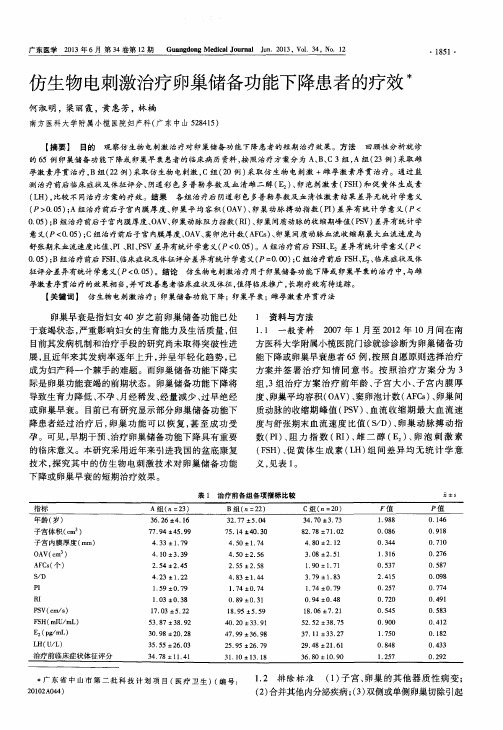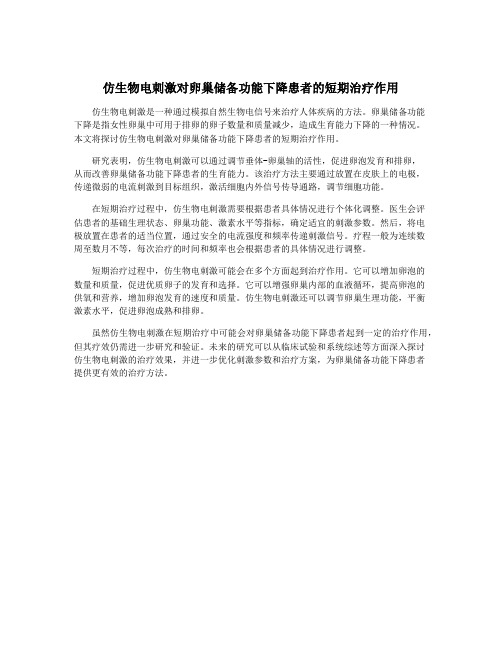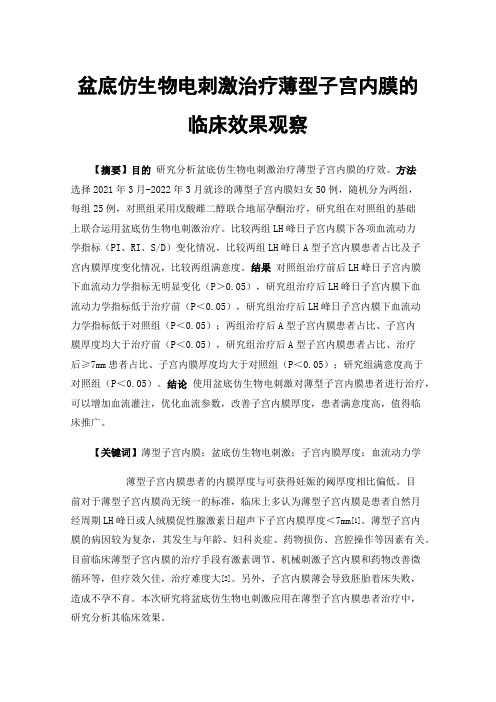仿生物电刺激对卵巢储备功能下降患者的短期治疗作用
仿生物电刺激治疗卵巢储备功能下降患者的疗效

.
1 8 5 2.
堕 堂
! 箜3 4 鲞箜 塑
G l g d o n g ! d i c a l J o u r n a l J u n . 2 0 1 3 , V o 1 . 3 4 , N o . 1 2
的卵巢功能减退或早 衰; ( 4 ) 合并 严重心脑血管原发疾 病; ( 5 ) 3 个月内服用激素史 ; ( 6 ) 急性生殖道炎症 。 1 . 3 诊断标准 卵巢早衰诊断标准 : 女性在 4 0岁之前
意叉( P< O . 0 5 ) ; c组治疗前后子宫 内膜厚度、 O A V、 窦卵泡计数 ( A F C s ) 、 卵巢间质动脉 血流收缩期最 大血流速度与
舒 张期末血流速度 比值 、 P I、 R I 、 P s V差异有统计 学意义( P< 0 . 0 5 ) 。A组治疗前后 F S H、 E 2差异有统计学意义( P< 0 . 0 5 ) ; B组 治疗前后 F S H、 临床症状及体征评分差异有统计 学意义( P= 0 . 0 0 ) ; C组治疗前后 F S H、 E 2 、 临床症状及体 征评分差异有统计 学意义( P< 0 . 0 5 ) 。结论 仿生物电刺激治疗用于卵巢储备功 能下降或 卵巢早 衰的 治疗 中, 与雌 孕激素序贯治疗的效果相 3, - 并可改善 患者 临床 症状及体征 , " 值得 , l 盘 床推广 , 长期疗效有待追踪 。
孕 激素序 贯治疗 , B组 ( 2 2例 ) 采取 仿生物 电刺激 , c组 ( 2 0例 ) 采取仿 生物 电刺激 +雌孕激 素序贯 治疗。通过监 测 治疗前后 临床 症状及体征评分、 阴道 彩 色多普勒参 数及血 清雌二 醇 ( E : ) 、 卵泡刺 激素 ( F S H) 和促 黄体 生成素 ( L H) , 比较 不同治疗方案 的疗效。结果 各组 治疗后 阴道彩 色多普勒参数及血 清性 激素结果 差异 无统计 学意 义 ( P> 0 . 0 5 ) ; A组 治疗前后 子宫 内膜厚 度、 卵巢 平均容积 ( O A V) 、 卵巢动脉搏 动指数 ( P I ) 差 异有统计 学 意义 ( P< 0 . 0 5 ) ; B组 治疗前后子宫 内膜厚度、 O A V、 卵巢动脉 阻力指数 ( R I ) 、 卵巢间质动脉的收缩期峰值( P s V) 差异有统计 学
仿生物电刺激对卵巢储备功能下降患者的短期治疗作用

仿生物电刺激对卵巢储备功能下降患者的短期治疗作用
仿生物电刺激是一种通过模拟自然生物电信号来治疗人体疾病的方法。
卵巢储备功能
下降是指女性卵巢中可用于排卵的卵子数量和质量减少,造成生育能力下降的一种情况。
本文将探讨仿生物电刺激对卵巢储备功能下降患者的短期治疗作用。
研究表明,仿生物电刺激可以通过调节垂体-卵巢轴的活性,促进卵泡发育和排卵,
从而改善卵巢储备功能下降患者的生育能力。
该治疗方法主要通过放置在皮肤上的电极,
传递微弱的电流刺激到目标组织,激活细胞内外信号传导通路,调节细胞功能。
在短期治疗过程中,仿生物电刺激需要根据患者具体情况进行个体化调整。
医生会评
估患者的基础生理状态、卵巢功能、激素水平等指标,确定适宜的刺激参数。
然后,将电
极放置在患者的适当位置,通过安全的电流强度和频率传递刺激信号。
疗程一般为连续数
周至数月不等,每次治疗的时间和频率也会根据患者的具体情况进行调整。
短期治疗过程中,仿生物电刺激可能会在多个方面起到治疗作用。
它可以增加卵泡的
数量和质量,促进优质卵子的发育和选择。
它可以增强卵巢内部的血液循环,提高卵泡的
供氧和营养,增加卵泡发育的速度和质量。
仿生物电刺激还可以调节卵巢生理功能,平衡
激素水平,促进卵泡成熟和排卵。
虽然仿生物电刺激在短期治疗中可能会对卵巢储备功能下降患者起到一定的治疗作用,但其疗效仍需进一步研究和验证。
未来的研究可以从临床试验和系统综述等方面深入探讨
仿生物电刺激的治疗效果,并进一步优化刺激参数和治疗方案,为卵巢储备功能下降患者
提供更有效的治疗方法。
盆底仿生物电刺激治疗薄型子宫内膜的临床效果观察

盆底仿生物电刺激治疗薄型子宫内膜的临床效果观察【摘要】目的研究分析盆底仿生物电刺激治疗薄型子宫内膜的疗效。
方法选择2021年3月-2022年3月就诊的薄型子宫内膜妇女50例,随机分为两组,每组25例,对照组采用戊酸雌二醇联合地屈孕酮治疗,研究组在对照组的基础上联合运用盆底仿生物电刺激治疗。
比较两组LH峰日子宫内膜下各项血流动力学指标(PI、RI、S/D)变化情况,比较两组LH峰日A型子宫内膜患者占比及子宫内膜厚度变化情况,比较两组满意度。
结果对照组治疗前后LH峰日子宫内膜下血流动力学指标无明显变化(P>0.05),研究组治疗后LH峰日子宫内膜下血流动力学指标低于治疗前(P<0.05),研究组治疗后LH峰日子宫内膜下血流动力学指标低于对照组(P<0.05);两组治疗后A型子宫内膜患者占比、子宫内膜厚度均大于治疗前(P<0.05),研究组治疗后A型子宫内膜患者占比、治疗后≥7mm患者占比、子宫内膜厚度均大于对照组(P<0.05);研究组满意度高于对照组(P<0.05)。
结论使用盆底仿生物电刺激对薄型子宫内膜患者进行治疗,可以增加血流灌注,优化血流参数,改善子宫内膜厚度,患者满意度高,值得临床推广。
【关键词】薄型子宫内膜;盆底仿生物电刺激;子宫内膜厚度;血流动力学薄型子宫内膜患者的内膜厚度与可获得妊娠的阈厚度相比偏低。
目前对于薄型子宫内膜尚无统一的标准,临床上多认为薄型子宫内膜是患者自然月经周期LH峰日或人绒膜促性腺激素日超声下子宫内膜厚度<7mm[1]。
薄型子宫内膜的病因较为复杂,其发生与年龄、妇科炎症、药物损伤、宫腔操作等因素有关。
目前临床薄型子宫内膜的治疗手段有激素调节、机械刺激子宫内膜和药物改善微循环等,但疗效欠佳,治疗难度大[2]。
另外,子宫内膜薄会导致胚胎着床失败,造成不孕不育。
本次研究将盆底仿生物电刺激应用在薄型子宫内膜患者治疗中,研究分析其临床效果。
1资料与方法1.1一般资料选择2021年3月-2022年3月在寿光市妇幼保健院妇孺国医堂就诊的薄型子宫内膜妇女50例。
探讨仿生物电刺激对产妇产后的康复效果

探讨仿生物电刺激对产妇产后的康复效果【摘要】产妇在产后需要进行康复来恢复身体健康。
本文探讨了仿生物电刺激对产妇产后康复的效果。
首先介绍了仿生物电刺激的原理,然后分析了产妇产后康复的重要性。
接着探讨了仿生物电刺激在产妇产后康复中的应用,并介绍了临床研究方法及实验结果分析。
研究表明,仿生物电刺激对产妇产后康复具有显著的促进作用。
结论部分指出了仿生物电刺激对产妇产后康复的积极意义,展望了未来的研究方向。
总结认为,仿生物电刺激有助于产妇产后康复,为其恢复身体健康起到了重要作用。
【关键词】关键词:仿生物电刺激、产妇产后康复、研究背景、研究目的、研究意义、原理、重要性、临床应用、研究方法、实验结果分析、结论、未来研究方向、总结、展望。
1. 引言1.1 研究背景产后康复是指产妇经过分娩后,身体恢复至产前状态的过程。
随着现代社会生活水平的提高,产妇对于产后康复的需求也越来越高。
传统的康复方法往往效果有限,不能满足产妇的需求。
寻找新的康复方法成为当前研究的焦点之一。
仿生物电刺激作为新兴的康复方法,逐渐受到学术界和临床医生的关注。
本研究将探讨仿生物电刺激对产妇产后康复的效果,希望通过科学的实验证据,为产妇康复提供新的方法和方向。
过去的研究表明,仿生物电刺激可以促进神经再生,改善肌肉功能,加速伤口愈合,有助于促进身体的康复。
本研究将进一步探讨仿生物电刺激在产妇产后康复中的应用,希望为产妇提供更有效的康复方案,提高生活质量。
1.2 研究目的本研究的目的在于探讨仿生物电刺激对产妇产后康复的效果,评估其在促进产妇身体功能恢复、缓解产后疼痛及焦虑情绪、改善生活质量等方面的作用。
通过系统地研究和分析,我们希望揭示仿生物电刺激在产妇产后康复中的潜在机制,为临床实践提供科学依据,促进产妇康复工作的进一步发展。
我们希望通过本研究的开展,能够为提高产妇产后康复效果、促进产妇健康和幸福做出贡献。
1.3 研究意义产妇是一个特殊的群体,她们在生产过程中经历了巨大的身体变化和应激,产后康复对于她们的健康至关重要。
仿生物电刺激基础知识 常用治疗方案 仿生物电刺激技术在女性不孕症的临床应用PPT课件

电生理技术在女性生殖临床的应用
1、薄型子宫内膜 2、改善子宫内膜容受性 3、宫腔粘连术后子宫内膜修复 4、宫腔积液 5、排卵障碍 6、卵巢低反应 7、卵巢储备功能低下 8 、多囊卵巢综合征 9、复发性流产 10、反复移植失败 11、胚胎移植
一、盆底仿生物电刺激在薄型子宫内膜的应用
1. 中华医学会生殖医学分会第四届委员会《辅助生殖技术中异常子宫内膜诊 疗的中国专家共识》及加拿大生育学会于 2019 年制订的《辅助生殖技 术中薄型子宫内膜的管理》:在成熟卵泡直径≥18 mm或 HCG 扳机日, 经超声检测子宫内膜厚度 < 7 mm为薄型子宫内膜。
禁忌症
1. 严重认知障碍患者, 2. 恶性肿瘤患者、 3. 癫痫患者、 4. 孕妇、 5. 植入式电 6. 子装置(例如心脏起搏器); 7. 急性化脓性炎症、 8. 出血倾向、 9. 血栓性静脉炎、 10. 活动性肺结核、 11. 治疗部位有金属异物者: 12. 理疗电极片过敏; 13. 月经期(禁使用盆展治疗头)
女性不孕症
• 定义:不孕症是一种低生育力状态,指一对配偶未采取避孕措施, 有规律性生活至少12个月未能获得临床妊娠。
• 世界卫生组织将不孕症列为仅次于肿瘤和心脑血管病威胁人类健康 的第三大疾病。
• 不孕不育患者超过5000万,占育龄人口12.5%~15%,每6-8对夫妇 中就有一对遭不孕不育问题。
人工流产并发症-子宫内膜损伤
损伤原因: 手术流产宫腔操作导致子宫内膜基底层损伤,纤维结缔组织增生和子官内膜再生障碍, 进而使子宫内膜修复障碍或致宫腔粘连,严重影响胚胎着床,造成继发性不孕。患者 通常伴有痛经、经量减少甚至闭经等症状。 发生率: 有研究表明,1次人工流产术后发生薄型子宫内膜的可能性为20%,2次及以上者薄 型子宫内膜的发生率上升到53.33%。
仿生物电刺激治疗对卵巢储备功能下降的作用初探的开题报告

仿生物电刺激治疗对卵巢储备功能下降的作用初探
的开题报告
标题:仿生物电刺激治疗对卵巢储备功能下降的作用初探
研究背景和意义:卵巢储备功能是女性生育能力的重要指标,随着
女性年龄的增长,卵巢储备功能逐渐下降,导致月经异常、不孕等问题。
仿生物电刺激是一种新型治疗技术,通过对人体组织施加微弱电刺激来
达到治疗效果。
近年来,仿生物电刺激在女性生育健康领域得到了广泛
关注,然而对于其治疗卵巢储备功能下降的作用尚未有深入研究。
因此,本研究旨在探究仿生物电刺激对卵巢储备功能下降的作用,为女性生育
健康提供一种新的治疗方案。
研究内容和方法:本研究将选取一定数目的卵巢储备功能下降的女
性进行实验,分为治疗组和对照组,每组的女性人数相等。
治疗组采用
仿生物电刺激治疗,对照组采用常规方法进行治疗。
在治疗前后对两组
女性的卵巢功能指标进行检测,包括日习惯性体温曲线、FSH、LH、E2、P等指标,并进行比较分析。
预期结果和意义:本研究预计能够从科学的角度探究仿生物电刺激
治疗对卵巢储备功能下降的作用,为女性生育健康提供新的治疗方案和
方法,有助于提高卵巢储备功能的检测和治疗水平,为女性的生育健康
保驾护航。
仿生物电刺激对卵巢储备功能下降患者的短期治疗作用
仿生物电刺激对卵巢储备功能下降患者的短期治疗作用
随着现代化生活方式的普及和延长,女性卵巢功能下降的问题越来越受到关注。
随着
年龄的增长,女性的卵巢储备功能开始下降,导致激素水平的改变和生殖能力的下降。
寻
找提高卵巢储备功能的方法成为了研究的热点。
1. 提高卵巢功能:仿生物电刺激可以通过调节卵巢内的激素水平,刺激卵巢发育和
孕激素的分泌,从而提高卵巢储备功能。
研究表明,通过仿生物电刺激治疗,患者的卵巢
储备功能可以得到改善,从而提高生殖能力。
2. 改善排卵功能:卵巢储备功能下降患者常常伴随着排卵不规律或者排卵功能低下
的问题。
仿生物电刺激可以通过刺激卵巢的神经系统,改善排卵功能,使患者恢复正常的
排卵周期和卵子质量。
3. 促进卵泡生长:卵泡是孕激素释放的主要来源,也是受精卵的产生和发育的基础。
卵巢储备功能下降患者常常伴随着卵泡发育不良的问题。
仿生物电刺激可以促进卵泡的生
长和发育,增加卵子的数量和质量。
4. 增加子宫内膜厚度:子宫内膜是胚胎着床的关键环节,对生殖能力有着重要影响。
卵巢储备功能下降常常伴随着子宫内膜厚度不足的问题。
仿生物电刺激可以增加血液循环,促进子宫内膜的生长和修复,从而增加子宫内膜的厚度。
仿生物电刺激对卵巢储备功能下降患者的短期治疗作用
仿生物电刺激对卵巢储备功能下降患者的短期治疗作用仿生物电刺激是一种利用生物电的原理来刺激人体细胞活动的治疗方法,通过调节细胞的离子平衡和电位,促进细胞的代谢和功能恢复。
近年来,一些研究表明仿生物电刺激对卵巢储备功能下降患者的短期治疗具有一定的效果,本文将对相关研究进行综述,并就其疗效和机制进行讨论。
研究表明,通过仿生物电刺激可以促进卵巢动情的卵泡发育和排卵的过程,提高卵巢储备功能下降患者的生育能力。
一项由中国科学家开展的临床研究显示,在接受仿生物电刺激治疗的卵巢储备功能下降患者中,约有60%的患者在治疗后成功怀孕,相比之下,传统治疗方法的成功率只有30%左右。
这表明仿生物电刺激对改善卵巢储备功能下降具有明显的疗效。
一些动物实验也证实了仿生物电刺激对卵巢储备功能的短期治疗效果。
一项对小鼠进行的实验发现,通过仿生物电刺激可以明显增加小鼠卵巢中的卵泡数量和质量,促进卵泡的发育和排卵过程。
这些实验结果无疑为仿生物电刺激作为治疗卵巢储备功能下降的新方法提供了坚实的科学依据。
1. 促进卵泡发育和排卵:仿生物电刺激通过调节卵巢组织中的离子平衡和电位,促进卵泡的成熟和排卵的进行。
这有助于提高卵巢储备功能下降患者的生育能力。
2. 促进卵巢血液循环:仿生物电刺激可以促进卵巢组织的血液循环,增加营养物质和氧气的供给,改善卵巢组织的微环境,有利于卵泡的发育和成熟。
3. 调节卵巢内分泌:仿生物电刺激可以影响卵巢组织中的内分泌物质的合成和分泌,调节卵巢功能,促进卵泡发育和排卵。
仿生物电刺激对卵巢储备功能的短期治疗效果可能涉及多种生物学机制,这些机制相互作用,共同促进卵巢的生理功能恢复。
三、技术及风险分析虽然仿生物电刺激在治疗卵巢储备功能下降患者中显示出良好的疗效,但其技术还存在一定的风险。
目前,该技术在临床上仍处于探索阶段,尚未形成统一的治疗方案和操作规范。
由于患者的身体状况和生理特点存在差异,导致治疗效果可能会有所不同,因此需要进一步完善治疗方案,提高治疗的个性化水平。
仿生物电刺激对卵巢储备功能下降患者的短期治疗作用
仿生物电刺激对卵巢储备功能下降患者的短期治疗作用随着生活水平的不断提高和生活方式的转变,不孕不育问题也愈发严重。
卵巢功能下降是造成生育障碍的主要原因之一,而随着年龄的增长和生活压力的增加,卵巢功能下降的现象也日益普遍。
针对卵巢功能下降患者的治疗方式也在不断改进和探索,其中仿生物电刺激技术是近年来备受研究关注的一种治疗手段。
本文将探讨仿生物电刺激对卵巢储备功能下降患者的短期治疗作用。
一、卵巢储备功能下降的危害卵巢储备功能是指女性卵巢内可供排卵的卵泡数量,也是女性生育能力的一个重要指标。
卵巢储备功能下降会导致排卵障碍,月经不调,甚至不孕不育的问题。
而且,卵巢储备功能下降与女性生育能力的下降密切相关,一旦出现卵巢储备功能下降,就可能意味着生育能力的严重下降,甚至无法自然怀孕。
卵巢储备功能下降的状况对女性的身心健康都会造成严重的影响。
二、仿生物电刺激技术的原理仿生物电刺激技术是一种应用微电流刺激生物器官的治疗方法,通过模拟生物电场的特性,以微电流的方式刺激生物细胞,促进细胞新陈代谢,增强细胞活力,从而达到治疗和改善组织功能的效果。
在治疗卵巢储备功能下降的过程中,仿生物电刺激技术能够刺激卵巢组织,促进卵泡生长和发育,提高卵巢储备功能,从而改善患者的生育能力。
三、仿生物电刺激技术对卵巢储备功能下降患者的短期治疗作用近年来,有越来越多的研究表明,仿生物电刺激技术对卵巢储备功能下降患者的短期治疗具有明显的效果。
一方面,仿生物电刺激技术能够刺激卵巢组织,促进卵泡的生长和发育,提高卵巢储备功能。
研究表明,通过仿生物电刺激技术治疗后,患者的卵巢储备功能有明显的改善,卵泡数量和质量均有所提高。
仿生物电刺激技术还能够调节内分泌系统,平衡雌激素和孕激素水平,改善月经不调症状,恢复正常的生理周期,为正常生育创造条件。
仿生物电刺激技术对卵巢储备功能下降患者具有显著的短期治疗作用。
四、仿生物电刺激技术的优势和局限性与传统的药物治疗和手术治疗相比,仿生物电刺激技术具有独特的优势。
生物反馈治疗应用于卵巢储备功能低下和薄型子宫内膜患者中的效果
2019年2月临床医学DOI :10.19347/ki.2096-1413.201904004基金项目:广西壮族自治区卫生和计划生育委员会自筹经费科研课题(No.Z20170002)。
作者简介:欧红(1971-),女,汉族,广西南宁人,副主任医师,学士。
研究方向:妇科微创和妇科内分泌。
导致卵巢储备功能低下的原因较多,多种因素共同作用下损伤卵子,导致卵巢功能减退、发生早衰,影响患者正常生育;此外子宫内膜厚度、形态、代谢状态及内分泌功能均受卵巢分泌的性激素影响较大,一旦卵巢早衰可能引起不孕情况[1]。
正常女性排卵1次/月。
另外,妊娠成功率与子宫内膜容受性关系密切,子宫内膜薄厚度是决定胚胎发育的重要因素,如薄型子宫内膜患者,可能存在妊娠率较低情况[2]。
本研究分析生物反馈治疗在卵巢储备功能低下和薄型子宫内膜患者中的应用效果。
1资料与方法1.1一般资料选择我院2016年1月至2016年10月收治的100例卵巢储备功能低下或薄型子宫内膜患者,将其随机分为观察组与对照组,各50例。
观察组年龄24~40岁,平均(29.9±3.1)岁。
对照组年龄25~40岁,平均(29.5±3.0)岁。
两组患者年龄比较,差异不具有统计学意义(P >0.05)。
本研究在取得所有患者知情同意,且在获得医院伦理委员会批准后进行。
纳入标准:有妊娠计划;卵巢储备功能低下[诊断参照美国疾病预防控制中心辅助生育协会(SART-CDC )对卵巢储备功能减退定义,即在年龄、遗传因素、医源性或手术原因作用下导致的卵巢内存留卵子的质量和数量下降],薄型子宫内膜诊断标准尚不一致,常规而言月经期子宫内膜约为1~4mm ,早卵泡期为4~8mm ,晚卵泡期为8~14mm ,分泌期为7~14mm ,本研究参考相关文献[3],以排除子宫内膜厚度<6mm 为薄型子宫内膜,观察3个自然排卵周期。
排除标准:合并其他先天性疾病患者;子宫内膜疾病患者;其他因素导致不孕患者;近期接受放化疗、激素治疗患者;单侧卵巢患者[4-5]。
- 1、下载文档前请自行甄别文档内容的完整性,平台不提供额外的编辑、内容补充、找答案等附加服务。
- 2、"仅部分预览"的文档,不可在线预览部分如存在完整性等问题,可反馈申请退款(可完整预览的文档不适用该条件!)。
- 3、如文档侵犯您的权益,请联系客服反馈,我们会尽快为您处理(人工客服工作时间:9:00-18:30)。
仿生物电刺激对卵巢储备功能下降患者的短期治疗作用作者:李雅丹来源:《中外医学研究》2019年第35期【摘要】目的:評价仿生物电刺激治疗对卵巢储备功能下降患者的短期疗效。
方法:选择笔者所在医院2018年1-12月83例卵巢储备功能下降患者作为研究对象,采用隐匿数字随机法分为两组,对照组41例采用雌孕激素序贯治疗;观察组42例采用仿生物电刺激治疗,监测治疗前后临床症状及体征评分、阴道彩色多普勒参数,以及血清雌二醇(E2)、卵泡刺激素(FSH)和促黄体生成素(LH),比较两组疗效。
结果:观察组治疗后LH、FSH水平为(26.17±1.65)U/L、(43.25±3.69)mIU/ml,分别低于治疗前的(38.16±1.80)U/L、(54.14±4.77)mIU/ml,差异有统计学意义(P<0.05)。
观察组治疗后E2水平为(43.82±7.90)pg/ml,与治疗前的(41.16±4.27)pg/ml比较,差异无统计学意义(P>0.05)。
对照组治疗后E2水平较治疗前明显升高,且高于观察组治疗后E2水平,差异有统计学意义(P<0.05)。
两组治疗后LH、FSH水平差异无统计学意义(P>0.05)。
观察组治疗后PI、OAV、AFCs分别为(1.90±0.31)、(5.06±0.62)cm3、(2.18±0.34)个,均高于治疗前的(1.42±0.32)、(4.29±0.51)cm3、(1.55±0.28)个,差异有统计学意义(P<0.05)。
两组治疗后PI、OAV、AFCs差异无统计学意义(P>0.05)。
结论:仿生物电刺激治疗卵巢储备功能下降短期可达到雌孕激素治疗相同的疗效,长期疗效有待进一步观察。
【关键词】仿生物电刺激卵巢储备功能下降短期疗效[Abstract] Objective: To evaluate the short-term efficacy of bionic bioelectrical stimulation in patients with decreased ovarian reserve function. Method: A total of 83 cases with decreased ovarian reserve function in our hospital from January to December 2018 were selected as research objects. The patients were randomly divided into two groups by hidden number method. The control group received sequential treatment with estrogen and progesterone. In the observation group, 42 patients were treated with bionic bioelectric stimulation. Clinical symptoms and signs scores, vaginal color Doppler parameters and serum estradiol (E2), follicle-stimulating hormone (FSH) and luteinizing hormone (LH) before and after treatment were monitored in the observation group. Result: The levels of LH and FSH in the observation group were (26.17±1.65) U/L and(43.25±3.69) mIU/ml, lower than (38.16±1.80) U/L and (54.14±4.77) mIU/ml before treatment, respectively, with statistically significant differences (P<0.05). E2 level in the observation group was (43.82±7.90) pg/ml after treatment, and (41.16±4.27) pg/ml before treatment, there was no statistically significant difference (P>0.05). After treatment, E2 level in the control group was significantly higher than that before treatment, and higher than that after treatment in the observation group, with statistically significant difference (P<0.05). There was no significant difference in LH and FSH levels between the two groups after treatment (P>0.05). After treatment, the number of PI, OAV and AFCs in the observation group was (1.90±0.31),(5.06±0.62) cm3 and (2.18±0.34), which were all higher than (1.42±0.32),(4.29±0.51) cm3 and (1.55±0.28) before treatment, and the differences were statistically significant (P<0.05). There were no significant differences in PI, OAV and AFCs between the two groups after treatment (P>0.05). Conclusion: Bionic bioelectrical stimulation can achieve the same short-term efficacy as estrogen and progesterone therapy in the treatment of decreased ovarian reserve function, while the long-term efficacy remains to be further observed.卵巢是女性性腺,作用是产生女性激素和成熟卵细胞,并在维持女性月经、生育力和生殖生理等内分泌功能方面发挥重要作用[1-2]。
受多种因素的影响,部分育龄女性会出现卵巢抑制素生成减少,卵巢储备功能下降,卵子质量的降低或窦卵泡数量减少,表现为月经稀少、紊乱、闭经及不孕,如不积极治疗在自然绝经前卵子耗竭导致卵巢早衰而失去治疗的机会[3-4]。
目前临床对于卵巢储备功能下降的干预手段主要是激素替代疗法,可迅速改善性激素水平和临床症状,但副反应也十分明显,即长期应用可能会导致心血管事件及肝肾功能异常,而且还会增加子宫内膜癌、乳腺癌的发病率[5]。
仿生物电刺激是物理治疗方法,近年来,该技术在盆底功能的治疗中发挥了一定的治疗作用,成为继内镜、妇科肿瘤后的又一妇科亚学科[6]。
本研究采用仿生物电刺激治疗了42例卵巢储备功能下降患者,对短期治疗作用进行评价,现报道如下。
1 资料与方法1.1 一般资料选取笔者所在医院2018年1-12月83例卵巢储备功能下降患者作为研究对象,本研究经院医学伦理委员会批准,患者知情同意研究方法,签署知情同意书。
纳入标准:符合《妇产科学》第7版卵巢储备功能下降相关诊断标准。
排除标准:(1)入组前3个月内服用过激素类药物;(2)有生殖器官器质性病变,严重心脑血管原发疾病;(3)过敏体质者,对本研究药物有过敏史;(4)合并生殖器官肿瘤需行手术切除;(5)合并严重骨质疏松症。
采用隐匿数字随机法分为两组,对照组41例,年龄33~56岁,平均(39.7±9.2)岁;观察组42例,年龄35~55岁,平均年龄(38.2±8.5)岁;两组年龄差异无统计学意义(P>0.05)。
1.2 方法1.2.1 对照组本组患者于月经第5天予戊酸雌二醇片/雌二醇环丙孕酮片复合包装(DELPHARM Lille S.A.S,进口药品注册证号H20120380,批准文号:国药准字J20130006)口服,1片/次,1次/d,连服21 d,3个月为1个疗程。
1.2.2 观察组采用PHENIX4型神经肌肉刺激治疗仪(广州市杉山医疗器械有限公司)的仿生物电刺激模式,将盆底肌肉治疗头放置于阴道内,最大电流强度为100 mA,波形维持恒定,开放4个电刺激通道如下:(1)频率15~85 Hz、脉宽500 μs;(2)频率8~32 Hz、脉宽320~740 μs;(3)频率30 Hz、脉宽500 μs;1 d治疗1次,每个疗程7次,共治疗3个疗程。
1.3 观察指标(1)内分泌指标:治疗前、疗程结束后抽取空腹静脉血,采用放射免疫法检测雌二醇(E2)、黄体生成素(LH)、卵泡刺激素(FSH);(2)卵巢功能:治疗前、疗程结束后于月经干净后第2~5天行彩色多普勒检查,记录窦卵泡计数(AFCs)、卵巢动脉搏动指数(PI),测量子宫长径、横径等指标,计算卵巢平均容积(OAV)。
1.4 统计学处理应用SPSS 18.0统计软件进行数据分析,E2、LH、AFCs等以(x±s)表示,采用t检验,计数资料以率(%)表示,采用字2检验,以P<0.05为差异有统计学意义。
2 结果2.1 两组治疗前后内分泌指标比较两组治疗前LH、FSH、E2水平差异无统计学意义(P>0.05)。
治療后两组LH、FSH水平较治疗前明显降低,差异有统计学意义(P<0.05)。
